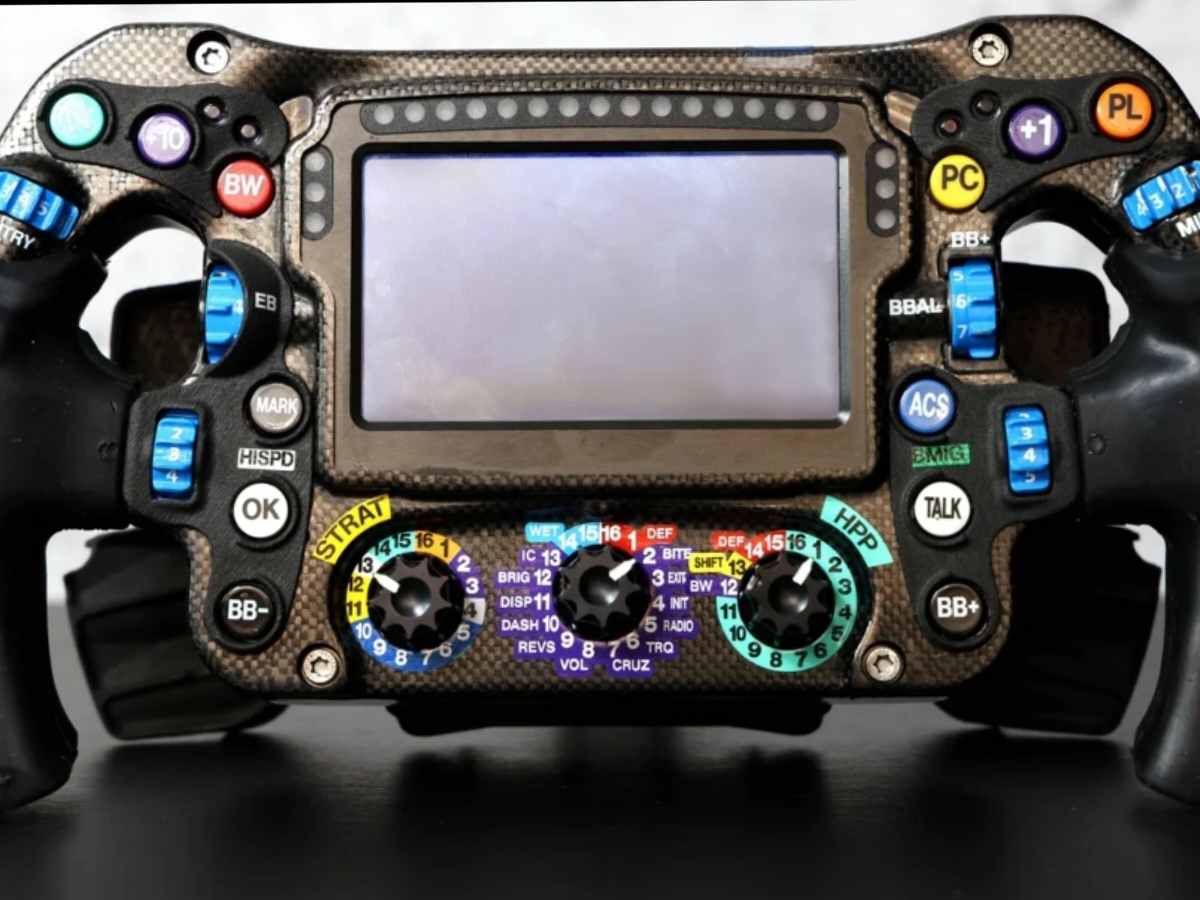How does an F1 steering wheel work?
Discover the science behind the working of an F1 steering wheel

An F1 steering wheel (Credits: The Drive)
🔍 Explore this post with:
The steering wheel is an essential component of an F1 car; it serves as the interface for communication between the driver and his vehicle. An F1 steering wheel’s primary job is to maneuver the vehicle. However, today’s steering wheel also controls different aspects of the car’s performance. This involves managing the power unit modes, which impact the internal combustion engine’s performance and the deployment of electrical energy.
The steering wheel also regulates differential balance, with a single or several scroll knobs controlling entry, mid, and exit settings. Additional controls on the steering wheel include rotary dials for changing differential settings and buttons for controlling various aspects of the car’s performance.
Discover: Can F1 drivers have body piercings?
The evolution of F1 steering wheels

The evolution of F1 steering wheels has been significant over the years. At the beginning of the Formula 1 era, the wheel was as simple as possible and had only a few functions. However, over time, more control has been put at the driver’s fingertips, allowing them to adjust various aspects of the car’s performance. The evolution of F1 steering wheels can be seen in videos and photos that show how they have changed from simple three-spoke wheels to modern wheels packed with buttons and knobs. In Ferrari‘s hands, for example, the F1 steering wheel has evolved into a full-on computer system that can cost upwards of £100,000.
What are the buttons on an F1 steering wheel, and how does each work?

What is Pit Radio Button in F1?
The Pit Radio button is an important part of an F1 steering wheel. During a race, this button allows the driver to interact with the team’s pit staff. Communication between the driver and the team is critical in a high-pressure situation. Drivers can use the Pit Radio button to obtain critical instructions or information, as well as report any faults or issues with the car to the crew and any incidents on the circuit. This button is frequently utilized for pit stop strategy and tyre wear management.
What is DRS Button in F1?
Another important aspect of an F1 steering wheel is the Drag Reduction System (DRS) button. This button engages the vehicle’s DRS, which decreases drag and enhances speed. When the driver hits this button, an actuator in the center of the rear wing expands, decreasing drag and enhancing speed. This function is utilized to acquire a competitive advantage in a race by overtaking other cars.

What is Oil Button in F1?
The Oil button activates the extra oil pump, which delivers oil to the engine during a race. This button is important when the engine wants more lubrication or cooling since it ensures that it functions at its optimal temperature and does not overheat. During a race, it is critical to maintain the engine operating smoothly and avoid any technical troubles.
What is Drink Button in F1?

Throughout a race, the Drink button replenishes the driver’s fluids. This feature is critical given the extreme temperatures that drivers face during a race, which can contribute to dehydration. The water bottle is linked to a tube that passes through the roll hoop of the automobile and down to the driver’s helmet, allowing them to drink while driving. Adequate hydration aids the driver’s ability to keep the attention and perform at their peak.
What is Confirm Button in F1?
The Pit Confirm button is used to acknowledge instructions or information coming from the pit wall. After hearing a message from the team, drivers can confirm manually that they heard the message. This feature is important to ensure that the driver and the team are on the same page and avoid any miscommunication.
What is PL Button in F1?

The Pit Lane (PL) button maintains the appropriate pit lane speed even if the accelerator is mashed. This button is critical for ensuring that drivers enter and depart the pits at a safe speed. Overspeeding in the pit lane can incur penalties, making the PL button an essential component during a race.
What is Mark Button in F1?
The Mark button allows drivers to mark a specific location on the circuit for future reference. This function is beneficial for finding points of interest in the vehicle’s telemetry data, which may assist the driver and crew in making educated judgments regarding the vehicle’s performance.
What is Neutral Button in F1?

The Neutral button is used to disengage the gears and place the vehicle in neutral. This button is useful for starting the car as well as in circumstances where the driver wants to push or pull the vehicle. The Neutral button is essential for mechanics since it allows them to maneuver the automobile about the garage.
What is Brake Bias Button in F1?
Drivers may alter the braking balance between the front and back of the vehicle using the Brake Bias button. This function is critical for maximising braking and handling during a race. The brake balancing dial on the steering wheel may be modified, allowing the driver to fine-tune the car’s handling.
Whar is Engine Mode Button in F1?
One of the most important features of an F1 steering wheel is the engine mode button. This button allows the driver to change the performance characteristics of the engine based on the scenario. For example, a driver may want to tweak the engine for maximum power output during qualifying, yet during a race, they may want to focus on fuel consumption or energy recovery. The engine mode button allows drivers to make these modifications quickly and conveniently.
What is Overtake Button in F1?
The overtake button is another important component of an F1 steering wheel. This button offers a brief boost by deploying energy from the battery, providing drivers with the extra speed needed to overtake another car during a race or even to defend. The steering wheel knob may also be used to choose different modes for assaulting another vehicle during an overtaking maneuver.
What is The Multi-Function Display in F1?
Another key element on an F1 steering wheel is the MFD button. This button is used to access numerous tasks on the Multi-Function Display screen, which displays various performance information about the vehicle. Drivers may personalize this panel by assigning different buttons to functions like as DRS (Drag Reduction System), overtaking, and pit limitation.
What are Paddle Gear Shifters in F1?

Installing gear paddles to the steering wheel was one of the most important changes. Formerly, F1 vehicles utilized a standard manual gear lever, but in the early 1990s, gear paddles were added, altering how drivers changed ratios. The paddle shift technology enables the driver to change ratios with their fingers without removing their hands from the steering wheel, making gear changes quicker and more economical. This increase in response time improves the car’s overall performance and gives drivers a competitive advantage.
What is Clutch in F1?

The clutch paddle is another important component of an F1 steering wheel. The clutch paddle is used to engage and release the clutch, which is essential for fast propelling the automobile off the starting line. The clutch paddle is usually found at the rear of the steering wheel and is actuated with the driver’s left hand. F1 has a semi-automatic gearbox, eliminating the need for the driver to utilize a clutch pedal to change gears. Yet, the clutch paddle is used in particular instances, such as starting the vehicle from a stop and during the start of the race to get the perfect launch off the line.
How are the F1 steering wheels made?

The steering wheel is one of the most critical parts of an F1 car, and it plays a vital part in assisting drivers in controlling their vehicle throughout a race. These wheels are not only lightweight but also sturdy and filled with features that drivers may utilize to change the performance of their cars during a race. Carbon fiber is a key material in F1 steering wheels. This material is well-known for its outstanding strength and lightness, making it an excellent choice for steering wheels. Additional materials utilized to manufacture these wheels include fiberglass, silicon, titanium, and copper.
The F1 steering wheel production method is very sophisticated, involving hand-laying carbon fiber with some incorporated machined elements. The whole wheel is constructed of carbon fiber, including grips and electronics. One steering wheel takes around 80 minutes to construct without modification. During a race weekend, each F1 driver receives three to four wheels. According to some reports, at least five steering wheels are built for each of the team’s two racing drivers during the season, with three remaining with the team and two being taken by the drivers. Drivers occasionally pull out their steering wheels as a mark of triumph and raise them into the air to celebrate their victory.
F1 steering wheels are much more than a circular framework that allows the wheels to revolve. These wheels have a plethora of buttons, knobs, and switches that allow drivers to make real-time modifications to the performance of their vehicle. They also include gear shifters and a clutch on the rear of the steering wheel. A Formula One vehicle is nothing without a steering wheel, and drivers and teams customize them to their liking. It also acts as a source of information for the driver and allows us, the viewers, to see what the driver is doing with the car.
In case you missed it:
Have F1 drivers ever peed in their race suits?







